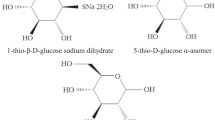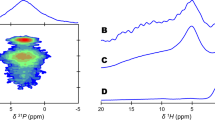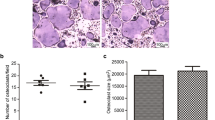Abstract
Histochemical observations on sections of the epiphyseal cartilage plate of young rabbit bones suggest that free anionic sites are present in the hypertrophic cartilage zone. This finding may help to explain why this cartilage zone takes up certain radionuclides and may throw light on the mechanisms involved in the initiation of calcifications.
This is a preview of subscription content, access via your institution
Access options
Subscribe to this journal
Receive 51 print issues and online access
$199.00 per year
only $3.90 per issue
Buy this article
- Purchase on Springer Link
- Instant access to full article PDF
Prices may be subject to local taxes which are calculated during checkout
Similar content being viewed by others
References
Williamson, M., and Vaughan, J., Proc. First Eur. Bone and Tooth Symp. Oxford, 71 (Pergamon Press, Oxford, 1964).
Peacocke, A. R., and Williams, P. A., Nature, 211, 1140 (1966).
Vigliani, F., and Marotti, F., La Clinica Ortopedica, 15, 521 (1963).
Herring, G. M., Proc. First Eur. Bone and Tooth Sump., Oxford, 263 (Pergamon Press, Oxford, 1964).
Herring, G. M., Proc. Fourth Eur. Symp. on Calcified Tissues, Leiden, 51 (Excerpta Medica Foundation, Amsterdam, 1966).
Andrews, A. T. de B., Herring, G. M., Biochim. Biophys. Acta, 101, 239 (1965).
Meyer, K., J. Histochem. Cytochem., 14, 605 (1966).
Van den Hooff, A., Acta Anat., 57, 16 (1964).
Lillie, R. D., Histopathologic Technic and Practical Histochemistry (Blakeston Co. Inc., Philadelphia, 1954).
Pearse, A. G. E., Histochemistry, Theotetical and Applied (J. and A. Churchill Ltd., London, 1960).
Stoward, P. J., J. Roy. Micros. Soc. (in the press).
Stoward, P. J., J. Roy. Micros. Soc. (in the press).
Hjertquist, S., Acta Soc. Med. Upsal., 69, 22 (1964).
Weatherell, J. A., and Weidmann, E. M., Biochem. J., 89, 265 (1963).
Campo, R. D., and Dziewiatkowski, D. D., J. Cell Biol., 18, 19 (1963).
Amprino, R., Acta Anat., 24, 121 (1955).
Szirmai, J. A., Van Boven de Tyssonsk, E., and Gardell, S., Biochim. Biophys. Acta. Acta, 136, 331 (1967).
Hirschman, A., and Dziewiatkowski, D. D., Science, 154, 393 (1966).
Spicer, S. S., J. Histochem. Cytochem., 13, 211 (1965).
Scott, J. E., and Dorling, J., Histochemie, 5, 221 (1965).
Leppi, T. J., and Stoward, P. J., J. Histochem. Cytochem., 13, 406 (1965).
Jibril, A. O., and Lindenbaum, A., Biochim. Biophys. Acta, 101, 236 (1965).
Author information
Authors and Affiliations
Rights and permissions
About this article
Cite this article
WILLIAMSON, M., VAUGHAN, J. Histochemistry of the Mucosaccharides in the Epiphyseal Plate of Young Rabbits. Nature 215, 711–714 (1967). https://doi.org/10.1038/215711a0
Received:
Published:
Issue Date:
DOI: https://doi.org/10.1038/215711a0
Comments
By submitting a comment you agree to abide by our Terms and Community Guidelines. If you find something abusive or that does not comply with our terms or guidelines please flag it as inappropriate.



